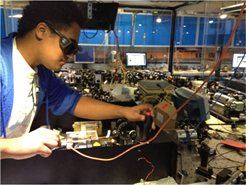Rupert Mellor

Summer Placement at The University of Sussex
Project Title: Frequency doubling of IR diode lasers
"My placement was at the University of Sussex, where I worked under Dr. Matthias Keller for the Trapped Ion Cavity Q.E.D. group. My job was to build a frequency doubling system using an infra-red laser and an optical frequency doubling cavity, for use ionising atoms in ion traps.
The first part of this was to build the controllers for the laser’s current and temperature, which involved printing the circuit boards, soldering all the components, drilling the boxes and assembling the final product, most of which I had not learnt to do beforehand!
The second part was to use these controllers to tune a laser block to the correct frequency. This is very delicate, as the laser diode is highly sensitive to temperature, and the accuracy needed was 0.00001 nm. A laser block consists of a diode, a heater, and a diffraction grating. To tune the laser, the diffraction grating must be reflecting the first order light straight into the diode itself, to stabilize the frequency, and must be reflecting the second order out into free space. Once that is done, very fine adjustment is carried out using a Piezo crystal which is attached to the grating. This taught me the importance of steady hands, and keeping an up to date lab book, so that if it all goes wrong, you know what the last position was that it all worked!
The third and final stage was to assemble the optical system, using mirrors, isolators and wedge plates. This was again, very sensitive to adjustment, and I learned the correct techniques for aligning lasers with wavemeters and optical fibre collimators. The most difficult part is to achieve optical resonance inside the cavity, as the beam must circulate perfectly between all four mirrors, whilst also passing through the non-linear crystal, which is a very fine adjustment.
After assembling the system the laser had to be locked to the cavity, so that any variations in frequency were cancelled out by a second Piezo behind a mirror in the cavity. After this, the frequency doubling had been achieved.
All in all it was a really good experience, and I would highly recommend doing a research placement! It showed me why we pay so much attention to detail in labs, and showed me how a career as a research physicist is completely different to office work, or working in an industrial laboratory. I look forward to using my new-found skills in laboratory work in the coming year!"